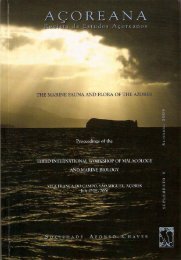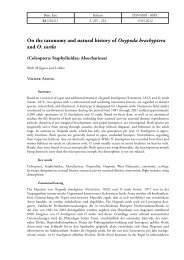The distribution of Zygonyx torridus in the Palaearctic (Odonata ...
The distribution of Zygonyx torridus in the Palaearctic (Odonata ...
The distribution of Zygonyx torridus in the Palaearctic (Odonata ...
You also want an ePaper? Increase the reach of your titles
YUMPU automatically turns print PDFs into web optimized ePapers that Google loves.
94<br />
Libellula 25 (1/2) 2006: 89-108<br />
Bernd Kunz, Stefan V. Ober & Re<strong>in</strong>hard Jödicke<br />
from Iran. All localities are situated with<strong>in</strong> a range characterized by a subtropical<br />
or Mediterranean climate. Such conditions are comparable with <strong>the</strong><br />
situation <strong>in</strong> sou<strong>the</strong>rn Africa beyond <strong>the</strong> tropical zone, where <strong>the</strong> species also<br />
occurs (see map <strong>in</strong> TARBOTON & TARBOTON 2002).<br />
<strong>The</strong>re are four centres <strong>of</strong> settlements: <strong>the</strong> Canary Islands (Fig. 2), <strong>the</strong><br />
northwestern Africa (Fig. 3a), <strong>the</strong> sou<strong>the</strong>rn Iberian Pen<strong>in</strong>sula (Fig. 3a), and <strong>the</strong><br />
Jordan Valley (Fig. 3b). Additionally, s<strong>in</strong>gle records are available from sou<strong>the</strong>rn<br />
Tunisia, Sicily, southwestern Turkey and sou<strong>the</strong>rn Iran. With respect to<br />
zoogeography, we grouped all records <strong>in</strong> <strong>the</strong>se four regions.<br />
(I) Canary Islands. — <strong>The</strong> oldest known specimen belongs to <strong>the</strong> type series<br />
from Tenerife (KIRBY 1889). Several o<strong>the</strong>r specimens also orig<strong>in</strong>ate from <strong>the</strong><br />
19th and early 20th Century and have been collected also <strong>in</strong> La Gomera and<br />
Gran Canaria. From <strong>the</strong> latter island comes <strong>the</strong> holotype <strong>of</strong> P. atlantica<br />
(MARTIN 1900). Recent records confirm that <strong>the</strong> species still <strong>in</strong>habits all <strong>of</strong><br />
<strong>the</strong>se three islands. In this respect, <strong>the</strong> actual f<strong>in</strong>d<strong>in</strong>g <strong>in</strong> La Palma (O. Brauner<br />
pers. comm.) is an <strong>in</strong>terest<strong>in</strong>g addition, encourag<strong>in</strong>g a systematic <strong>in</strong>vestigation<br />
<strong>of</strong> <strong>the</strong> whole archipelago. However, if <strong>the</strong> historic sources – especially<br />
BRAUER (1901) – are compared with recent reports, one gets <strong>the</strong> impression<br />
that <strong>the</strong> abundance <strong>of</strong> Z. <strong>torridus</strong> <strong>in</strong> <strong>the</strong> islands significantly decreased <strong>in</strong> <strong>the</strong><br />
course <strong>of</strong> <strong>the</strong> 20th Century, due to human impact on <strong>the</strong> natural freshwater<br />
resources (e.g., MALMQUIST et al. 1993, BEMMERLE 2005, O. Brauner, R. Busse,<br />
A. Schröter pers. comm.).<br />
(II) Northwestern Africa. — <strong>The</strong> oldest record from Morocco – a specimen<br />
from Fès stored <strong>in</strong> <strong>the</strong> ZMHB – has not been published before. All Moroccan<br />
localities are scattered around <strong>the</strong> High and Medium Atlas Mounta<strong>in</strong>s and <strong>the</strong><br />
Rif (JACQUEMIN & BOUDOT 1999) but <strong>the</strong>re are no records from <strong>the</strong> Anti Atlas<br />
and <strong>the</strong> Sahara. Locality 29, which was visited several times between 1982<br />
and 2002, marks <strong>the</strong> sou<strong>the</strong>rnmost record and is next to <strong>the</strong> Canary Islands.<br />
<strong>The</strong> data <strong>in</strong>dicate a stable occurrence <strong>in</strong> Morocco, and <strong>the</strong>re is no <strong>in</strong>dication<br />
<strong>of</strong> a decl<strong>in</strong>e <strong>of</strong> <strong>the</strong> species <strong>in</strong> this region. <strong>The</strong> Tunisian locality differs from all<br />
Moroccan ones <strong>in</strong> be<strong>in</strong>g situated <strong>in</strong> <strong>the</strong> nor<strong>the</strong>rn edge <strong>of</strong> <strong>the</strong> Sahara. We observed<br />
<strong>in</strong>dividuals emerg<strong>in</strong>g from a mounta<strong>in</strong>ous brook with waterfalls, very<br />
close to <strong>the</strong> Algerian border. We suggest that similar habitats along <strong>the</strong> nor<strong>the</strong>rn<br />
edge <strong>of</strong> <strong>the</strong> Sahara <strong>in</strong> Algeria are also colonized and l<strong>in</strong>k <strong>the</strong> Tunisian locality<br />
with <strong>the</strong> Moroccan ones.<br />
(III) Sou<strong>the</strong>rn Europe. — <strong>The</strong> oldest <strong>in</strong>formation about <strong>the</strong> occurrence <strong>of</strong><br />
Z. <strong>torridus</strong> <strong>in</strong> Europe is an undated record from Spa<strong>in</strong> (NAVÁS 1906a). Over <strong>the</strong><br />
years more Spanish localities became known; hence <strong>the</strong> species has been judged<br />
a rare but regular <strong>in</strong>habitant <strong>of</strong> Europe (e.g., VAN TOL & VERDONK 1988).<br />
Although <strong>the</strong> data base <strong>of</strong> odonate field work <strong>in</strong> Spa<strong>in</strong> is relatively small (see<br />
OCHARÁN LARRONDO 1987), <strong>the</strong>re are a few <strong>in</strong>dications <strong>of</strong> long-term occupation<br />
<strong>of</strong> a given breed<strong>in</strong>g site. For <strong>in</strong>stance, at locality 41 <strong>the</strong> species was ob-
















